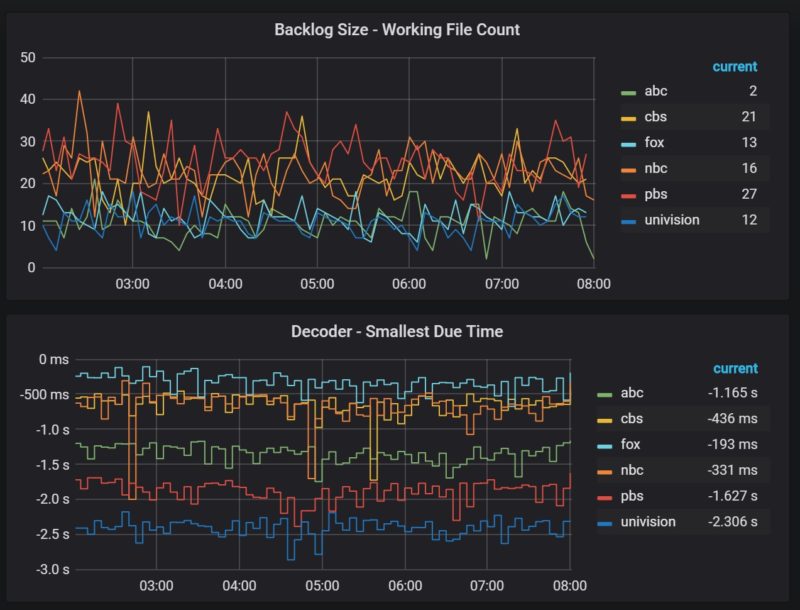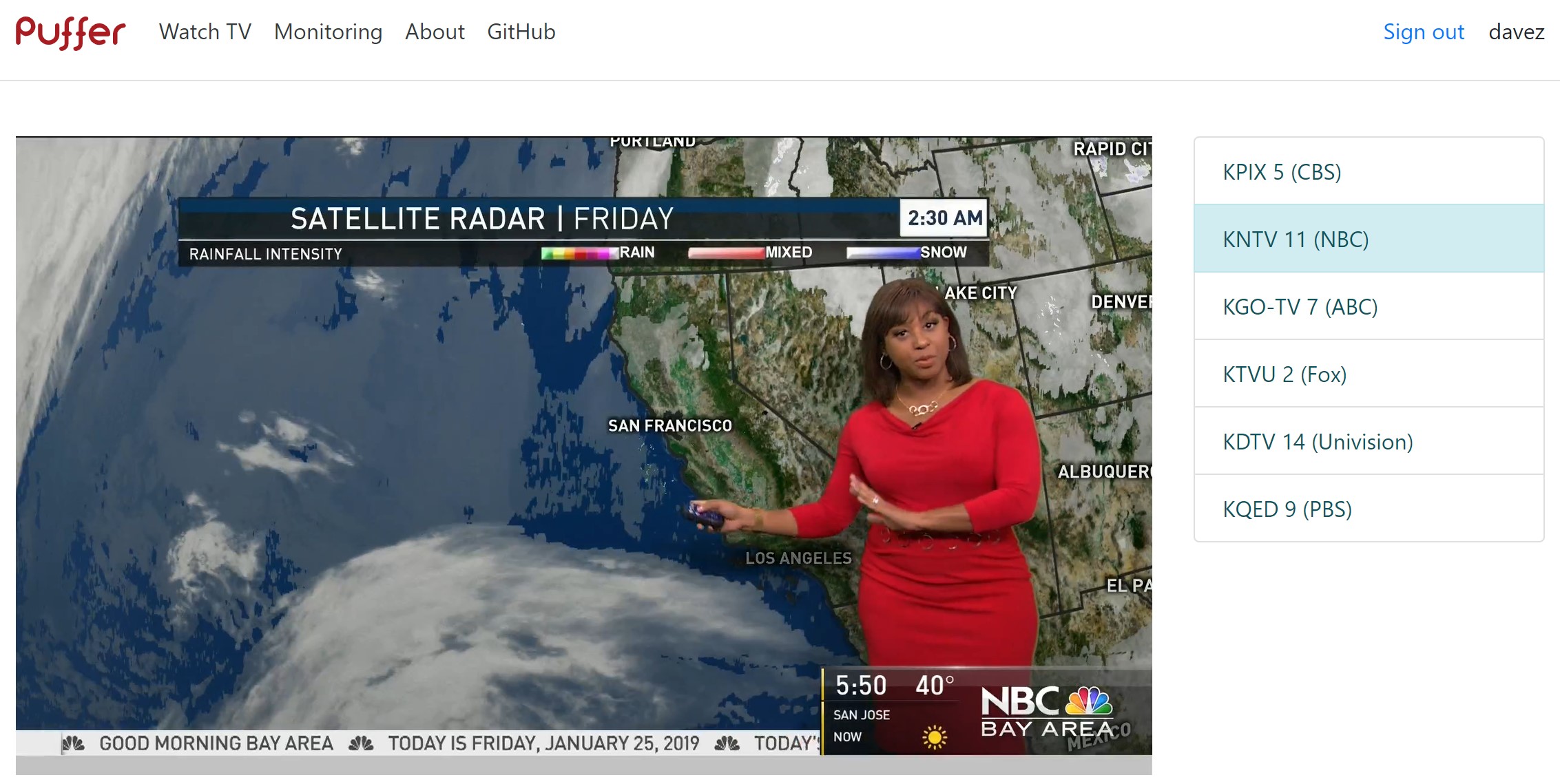Aereo may be long gone, but the dream of streaming affordable local television (without an antenna) lives on. And a Stanford University research project has answered the call with Puffer. We enjoy some television on-the-house and they use machine learning to improve video streaming algorithms:
We are trying to figure out how to teach a computer to design new algorithms that reduce glitches and stalls in streaming video (especially over wireless networks and those with limited capacity, such as in rural areas), improve picture quality, and predict how the capacity of an Internet connection will change over time.
The idea of this study is that about 500 people will watch TV channels here, streaming them over their Internet connections, and as they do, the Puffer website will automatically experiment with different algorithms that control the timing and quality of video sent to them, and will monitor how well the resulting computer-designed algorithms work. The more diverse the Internet connections that the 500 study participants use, the better the system will be able to learn, and the more robust the resulting computer-generated algorithms.
The TV channels are presented via a spartan but functional web player (that isn’t compatible with iPhone or iPad, sorry), with optional full-screen view, essentially encoding and re-transmitting Bay Area ABC, CBS, Fox, and PBS programming across the Internet.

I assume Netflix, YouTube, and the like similarly analyze their video presentation. But, as a non-profit, getting the technical data into the public domain would certainly serve the greater good – and possibly why there’s a legal exemption here. But no telling how long Puffer will remain available, so enjoy it while you can.
(Thanks for the tip, James L!)

Reading the Aereo decision, the supreme court said it was illegal because it “publicly performed” the TV channels when they retransmitted them. It was not tied to their charging for this service, so it should be covered by the same decision.
That said they could be covered by the same digital translator exemption that LoCast uses, where they are a non-profit and limited to people that live in the same location as the channels being retransmitted. Of course that exemption has not been tested in courts, but it does have a lot of precedent.
https://www.locast.org/
I’m not the same location… It’s on the honor system, so it seems, and they only asked if I’m in the US. I assume it’s not entirely kosher. I also assume they’ll shut it down before any legal action becomes a real problem for them. But, in the interim, folks are free to enjoy.
Which, Puffer? I believe LoCast does check, but I’m in NYC so I’m definitely in their area. I get YouTubeTV, but I tested LoCast and it worked great. If Puffer doesn’t at least make a token gesture to verify location, they definitely will have legal problems.
Yeah, Puffer – it’s based on west coast, I’m on east. I imagine they’re on shaky ground. But also as a respected university with what assumes is a finite timeframe, they’re probably OK for a bit. Wonder if LoCast isn’t worth going after or if it’s truly within its rights. Fun times!
I figured they let LoCast live for the time being because they’re non-profit, don’t charge anything, have precedent, check location, don’t offer a DVR, and most importantly, most people don’t know it exists.
Puffer will probably be allowed to continue for many of the same reasons, plus like you said it’s Stanford and only for a limited time.
it would seem to be obvious that charging people for a service that is otherwise free has caught up with cable operators and satellite providers…that is no logical reason why anyone should be prevented from watching programs that are available to all for FREE… it says here ….. the aero er.al decision was thought to provide “cover” . to the subscription operators and maybe even to correct b dillard who backed aero ……dont see how the powers that be go after a FREE SERVICE
PS i also have locast and dont understand why that bother with location service …this service and puffer ..are NOT like aero in that aero wanted you to rent the antenna …so that the …televison channels can be performed …in puffer and locast case you are being provided with the FREE SERVICE per their federal license …
@Paul T Well, yes and no, the decision basically said that Aereo was effectively acting as a cable company, and therefore bound by the Retransmission Consent rules of the Cable Act. I suppose Aereo could have gone to the broadcasters and negotiated a fair price, but at that point their business model is pretty much blown up.
@p Valdez…thanks I believe you are right they made the mistake of charging for something they were getting for free (just like the cable operators ) and of course Aero wanted to do it sans any fees to anyone .. while the cable and satellite guys where Paying …. (no offense to the purely legal perspective) noting ….it says here that dog cant hunt …
Do they get any exemption as an educational institution? That’s how music licensing works: it can be used “for educational purposes”
local tv unlike music is a FREE SERVICE why would you need a exemption if you are not selling or charging anything?
In theory couldn’t Aero have sold you the antenna and then charge rent and electric.
Totally enjoying the SF Bay Area feeds of my former hometown local broadcast channels. I’m out in Southern California’s Riverside County, and keep an account on YouTube TV with a SF Bay locality to access these channels Puffer currently is currently streaming. I’ll enjoy them while I can!
Paul T: “Publicly Performed” in copyright and in this SCOTUS ruling means that Aereo provided/streamed content protected by copyright to more than 3 people without obtaining the permission of the broadcaster–and worse, Areo was charging people to access the broadcaster content whose content was under copyright. SCOTUS was saying that Areo had to obtain the permission of each broadcaster, which in the case of a for profit business, broadcasters would most likely require $$ to be paid to the broadcaster, rather than allowing access at no charge, which the broadcasters are free to do if they wish.
In truth, Areo was found to have passed all the tests for concluding it was legal by EVERY lower court until SCOTUS got the case and issued its ruling. It is accurate to say that Areo exploited loopholes in the law, but that is legal. No court should do the job of Congress. It is for Congress to close the loopholes, not SCOTUS.
For once, I agreed with the late Associate Justice Scalia who made clear that he thought Areo was doing what Congress had not intended and that Areo was exploiting loopholes in the law to re-transmit the broadcaster without their permission, and additionally to make money while doing it, BUT despite his objections, Scalia voted in FAVOR of Areo because he believed it was for Congress to change the law and close any loopholes, not SCOTUS.
In fact, the SCOTUS decision wad so bad and so contrary to existing law and lower cour rulings, even prior SCOTUS rulings on this subject, that those who voted against Areo had to go out their ridiculous way in their ruling to make clear that the Areo decision should be seen as unique and should NOT be taken to apply to all sorts of other similar sevices and devices because the ruling was so contrary with previous rulings on this subject.
But even a SCOTUS ruling in FAVOR of Areo would have still meant a quick death for Areo because the broadcasters, through the powerful and almost always successful NAB,would have quickly drafted a bill closing the loopholes, payed Congress to approve the bill, and the President would most likely signed the Areo killing bill, and all this would have happened in mere WEEKS after the SCOTUS decision.
Bottom line: SCOTUS was saying to Aereo that permission from broadcasters was required, and if that meant paying the broadcasters, so be it.
Pablo Valdez: Yes, quite correct. I should have added, in addition to “publicly performed,” what you said, that SCOTUS took the view that Areo looked like an MVPD, acted like an MVPD, provided content like an MVPD, and charged money like an MVPD, so SCOTUS concluded Areo was an MVPD and was bound to retransmission acts covering MVPD’s. However, in truth, that is not necessarily the case, which is why the tests for personal and private fair use had been applied in every lower court ruling.
The SCOTUS ruling was still a bad decision because Areo still passed all the tests of being legal, and likely passed the tests of each of the members of SCOTUS who voted against Areo, but, instead they focused on further defining what an MVPD is, and that caused confusion in regards all manner of personal private use rulings in relation to devices and services. SCOTUS knew this contridiction in its ruling and was forced to state in its ruling to ignore the ruling, exceot in the case of Areo. SCOTUS over reached to further define an MVPD, in essence write legislation, but that is the role of for Congress; it is for Congress to legislate, to define and to write law.
In other words, Fair Use trumps copyright laws. At least as long copyright use of 1976 is law.
#harry must be the front row…..thanks for laying out how they found a dog that would hunt….
HarryKerryJr,
I agree with your statement… “It is for Congress to close the loopholes, not SCOTUS.” ONLY to the point that SCOTUS does not create, draft, write or in any way design laws. However, the Supreme Court certainly is the ONE body who’s solely responsible for the rigorous legal tests that Congress must rely upon while trying to design language to close such loopholes. In many situations, SCOTUS has literally pointed out existing “loopholes” contained within laws that where brought before them for entirely different reasons. However, during the drafting of their opinions, these areas of law would not withstand pressure testing, thus signaling to Congress that different, more specific language is needed.